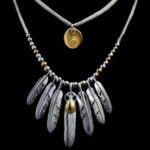In 1906, Alfred Van Cleef, son of a jeweler, and his brother-in-law Charles Arpels opened their first boutique at 22 Place Vendôme, giving birth to the Van Cleef & Arpels jewelry brand.
At its inception, they likely never imagined that this small boutique would endure for over a century. In this article, we’ll explore the changes Van Cleef & Arpels has undergone over the past 100 years and uncover what has made this venerable house a legend.
01.Early Style and Innovation
During the Roaring Twenties, Paris’s vibrant social atmosphere and entertainment scene attracted dignitaries from around the world. Many socialites became loyal fans of Van Cleef & Arpels. In 1925, the brand participated in the International Exhibition of Modern Decorative and Industrial Arts in Paris, winning the Grand Prix. This success led to an influx of high-profile clientele.


From 1926 to 1939, Estelle Arpels, Van Cleef’s daughter Renée Puissant, and the talented designer René-Sim Lacaze collaborated to create many classic designs. During this period, they developed several unique and outstanding techniques that gradually established Van Cleef & Arpels’ current reputation and distinctive style.

The Minaudière, born in 1933, replaced traditional makeup cases. Initially designed as a flat, rectangular box for easy handling, it featured multiple compartments for storing ladies’ cosmetics. Over time, the Minaudière and its velvet pouch gradually replaced handbags made of precious fabrics or leather that were used to complement women’s attire.
Early Minaudière styles featured radial spiral designs in their engraved lines, combined with thematic decorations and the Mystery Set technique. Other pieces utilized lacquer painting, scroll-shaped decorations, or diamond borders. By the late 1930s, decorative elements became more diverse, with lifelike birds and stylized plant motifs appearing.


In the same year, the famous Mystery Set technique was patented, marking a significant technological advancement in gemstone setting. The secret lay in creating a delicate metal grid and setting specially cut precious stones one by one. This technique was typically used for setting rubies, emeralds, and sapphires. Its uniqueness lay in hiding the setting, allowing each stone to display its full brilliance and making the pieces even more dazzling.




In 1939, the maison participated in the New York World’s Fair, introducing a series of innovative masterpieces, including the Passe-Partout jewelry. This serpentine chain with attached floral brooches could be worn as a necklace, bracelet, or belt, with the flowers detachable for use as separate brooches.


02.Post-War Style
After 1945, Van Cleef & Arpels’ Paris workshop began creating Ballerina and Fairy brooches, which had first appeared in the New York market. Each Ballerina brooch featured a rose-cut diamond face surrounded by rubies and emeralds.

The post-war period saw a revival of glamorous styles, with fashion and jewelry art intersecting. Gold jewelry was particularly popular, and Van Cleef & Arpels continuously released new creations.
By imitating various decorative element structures in yellow gold, they created jewelry pieces similar in style to women’s fashion accessories. Lace bow-inspired jewelry designs were especially popular in the 1940s, with polished and perforated yellow gold complementing diamonds beautifully.


The 1950s were a period of reconstruction. To meet changing customer needs, Van Cleef & Arpels ingeniously launched The Boutique jewelry series, along with many affordable jewelry pieces and accessory collections.

Since 1951, the Zip necklace, proposed by the Duchess of Windsor to Renée Puissant, became a darling of the high jewelry market. This zipper-inspired piece became one of the most representative classic designs in Van Cleef & Arpels’ high jewelry collection, wearable as both a necklace when open and a bracelet when closed.

03.The Emergence of Hedonism and Avant-Garde
The 1960s saw a prevalence of hedonism, with decorative arts flourishing in form, color, and materials. It seemed that any new element could be incorporated into decorative art designs. Socialites wearing haute couture from Yves Saint Laurent, Courrèges, and Paco Rabanne adorned their necks with the Alhambra four-leaf clover necklace made of yellow gold and precious stones.
Introduced in 1968, this iconic design featured a beaded border and clover motif made from hard stones like onyx, carnelian, agate, lapis lazuli, and coral.

The 1970s saw continued creation of Alhambra pieces, with the clover motif applied to bracelets, rings, brooches, earrings, necklaces, and watches. The La Boutique collection incorporated diverse precious stones at more accessible prices. Coral, a popular element in jewelry design at the time, was featured in pieces like the Rose de Noël brooch, with petals made of pink and white coral and a center of sparkling diamonds.

Van Cleef & Arpels drew inspiration from Indian jewelry influenced by hippie counterculture, creating diverse jewelry designs. Many pieces retained traditional styles, such as the Camellia earrings and Leaves brooch, crafted with rubies and diamonds using bezel or prong settings.
The 1970s marked the end of the post-war boom, known as the “Glorious Thirty Years,” witnessing rapid French development in innovation, economy, lifestyle changes, and new materials. The avant-garde fashion trends of the 70s were also reflected in jewelry design.

Extravagant necklaces remained popular must-haves, with the 1971 celebration of the 2500th anniversary of the Persian Empire in Persepolis inspiring the maison. This led to the creation of imaginative animal-themed jewelry masterpieces that continued throughout the decade.
04.Modern Style Establishing Luxury Positioning
The 1980s fashion trends were dominated by “order,” “simplicity,” and “dignity.” Rare jewels became more affordable and suitable for daily wear. Jewelry sets began to have a strong classical air, with subtle geometric lines outlining intricate structures.
Short necklaces returned to mainstream fashion in the 1980s as part of exquisite jewelry sets. Elegant and dignified chokers and chest armor necklace sets, adorned with rare gemstones and rich natural patterns, became increasingly popular. The Daisy set, treasured by Hollywood legend Elizabeth Taylor, exemplifies this type of jewelry ensemble.

From the 1990s, Van Cleef & Arpels held retrospective exhibitions of its collection pieces worldwide. In 2000, the brand joined the Richemont Group, underwent management changes, and subsequently launched multiple high jewelry collections inspired by fantastical worlds.

Looking back on nearly a century of Van Cleef & Arpels’ development, it’s clear that continuous innovation and change have allowed this high-end luxury brand to thrive for over a hundred years.

Unveiling the Secrets of Van Cleef & Arpels’ Century-Long Success in Luxury Jewelry
Tweet





